The Lecompton Constitution was drafted and signed in this building in 1857. Built in 1856, Constitution Hall is now a National Landmark and a museum. Located at 319 Elmore in Lecompton, Kansas.
The Lecompton Constitution was a document framed in Lecompton, the Territorial Capital of Kansas, in 1857 by Southern pro-slavery advocates of Kansas statehood. It contained clauses protecting slaveholding and a bill of rights excluding free blacks, and it added to the frictions leading up to the U.S. Civil War. Though it was rejected in a territorial election (January 1858), Pres. James Buchanan subsequently recommended statehood for Kansas under its provisions. Congress balked, and a compromise was offered calling for resubmission of the constitution to the territory’s voters. Kansas again rejected it the following August and was admitted to the Union as a free state on Jan. 29, 1861.
Constitution Hall, where the Lecompton Constitution document was drafted and signed in 1857, is now a National Landmark and a museum. Exhibits in the museum explain the Lecompton Constitution and its effects on the country, Bleeding Kansas, and Territorial Kansas. It is the oldest wood-framed building in Kansas still in its original location. The building has a copy of the Lecompton Constitution, the original being housed at the Kansas Historical Society in Topeka.
Timeline of the Lecompton Constitution:
January 1857– The Territorial Legislature passed “An act to provide for electing a convention to frame a state constitution.” This was the first step of the Lecompton Constitution movement. The election for 60 delegates to the constitution would take place on the 3rd Monday in June 1857. Delegates were then to meet at Lecompton to frame a constitution the 1st Monday in September 1857.
September 1857–Members of the Lecompton Constitutional Convention met in Lecompton the first week in September 1857. They opened their convention on the 2nd floor of Constitution Hall on September 7th and remained in session for four days. After electing permanent officers and choosing a slate of committees they recessed until October 19, 1857. They were waiting the outcome of the October 5th territorial election. Although this election did not appear to be as significant as the one in June for convention delegates, its outcome dramatically shook and shifted political power in the territory from pro-slavery to free-state control. Free-state men voted in this election and for the first time in Kansas history, a free-state majority was elected to the Kansas House and Senate.
October 19–November 8, 1857– The Lecompton Constitutional Convention meets at Constitution Hall in Lecompton, Kansas–the Territorial Capital of Kansas. Boycotted by free-soilers, the group adopts a proslavery constitution.
October 1857–Free-Stater James H. Lane protests the Lecompton Constitutional Convention at Constitution Hall in Lecompton.
December 7, 1857–Frederick Stanton, the acting governor, called this new free-state majority legislature into “extra” or “early” session in Lecompton. The House again met on the 2nd floor of Constitution Hall . This extra session convened for nine days and passed a total of six acts. Crowds of Free State Kansans led by James Lane’s militia paraded victoriously into Lecompton to listen to music and hear fiery anti-Lecompton oratory on the day the extra session convened.
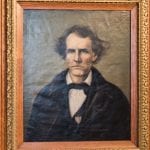
Portrait of James H. Lane at the Territorial Capital Museum in Lecompton, Kansas.
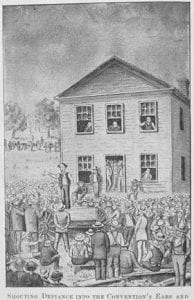
Free-Stater James Lane “shouts defiance into the convention’s ear and the battery’s muzzles” at Constitution Hall in Lecompton. The 1857 illustration is copied from “Life of General James H. Lane” by John I. Speer.
December 21, 1857–The Lecompton Constitution is ratified by Kansas voters. This election is tainted, as free-soilers continue to boycott.
February 2, 1858–President James Buchanan submits the Lecompton Constitution to Congress, recommending its approval and the admission of Kansas as a slave state.
February 6, 1858–An infamous floor brawl erupts as members of the U.S. House of Representatives debate the Lecompton Constitution.
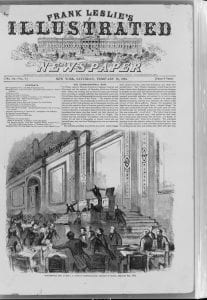
“The Most Infamous Floor Brawl in the History of the U.S. House of Representatives” February 06, 1858 the House of Representatives erupted as Members debated the Kansas Territory’s pro-slavery Lecompton Constitution. Frank Leslie’s Illustrated sketch depicts the melee at the base of the Speakers rostrum.
February 8, 1858–A House coalition of Northern Republicans and Free Soilers narrowly blocked referral of the Lecompton Constitution to the House Territories Committee.
March 23, 1858–The Senate approves the Lecompton Constitution and Kansas Statehood.
April 1, 1858–The House votes to resubmit the Lecompton Constitution to a popular vote in Kansas.
April 10, 1858–The House and Senate compromise on the Lecompton Constitution, agreeing to admit Kansas to the Union as a slave state if the constitution wins a popular vote.
June 16, 1858–Abraham Lincoln delivers his “House Divided” speech in accepting the Republican nomination for the Illinois Senate in Springfield, Illinois.
August – October, 1858–The Lincoln-Douglas debates take place in Illinois. The word “Lecompton” is mentioned at least 55 times during the debates.
August 2, 1858–In an open and fair election, Kansas voters reject the Lecompton Constitution.
October 4, 1858– Voters in Kansas overwhelmingly ratify an antislavery constitution.
Timeline, continued: After the Lecompton Constitution
The Lecompton Constitution divides the Political Parties
which leads Abraham Lincoln to win the 1860 Election.
April 23-May 3, 1860–The Democratic national convention in Charleston, South Carolina, fails to nominate a presidential candidate.
May 9, 1860– The Constitutional Union party forms in Baltimore and nominates John Bell of Tennessee for president.
May 16, 1860–The Republican convention meets in Chicago. Two days later, delegates endorse Abraham Lincoln for president.
June 18-23, 1860–Democrats reconvene in Baltimore and again fail to nominate a presidential candidate. The party splits–Stephen A. Douglas is nominated by the Northern wing; John C. Breckinridge is nominated by the more radical proslavery wing.
November 6, 1860–Lincoln wins the presidential election.
Dec. 20, 1860–South Carolina is the first state to succeed from the union. It is followed by other states.
January 29, 1861–Kansas is admitted to the United States as the 34th State. It is a free state.
February 18, 1861–Jefferson Davis is inaugurated as the President of the newly formed Confederate States of America.
April 12, 1861–Shots fired at Fort Sumter, South Carolina, between Confederate and Union troops. Kansas had been fighting years earlier, with the first casualties between pro-slavery and free state fighters occurring at the Battle of Fort Titus on August 16, 1856.
Timeline adapted from The Civil War Chronicle, Forward: William C. Davis, Consultant: Richard A. Sauers, Ph. D., LCCN: 2004106041
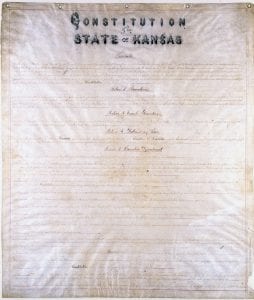
Title Page of the Lecompton Constitution drafted and signed in Constitution Hall in Lecompton, Kansas.
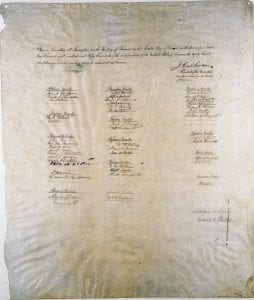
Signature Page of the Lecompton Constitution
Lecompton Constitution (excerpt of the 8 page document):
ARTICLE VII.– SLAVERY.
SECTION 1.
The right of property is before and higher than any constitutional sanction, and the right of the owner of a slave to such slave and its increase is the same and as inviolable as the right of the owner of any property whatever.
SECTION 2.
The Legislature shall have no power to pass laws for the emancipation of slaves without the consent of the owners, or without paying the owners previous to their emancipation a full equivalent in money for the slaves so emancipated. They shall have no power to prevent immigrants to the State from bringing with them such persons as are deemed slaves by the laws of any one of the United States or Territories, so long as any person of the same age or description shall be continued in slavery by the laws of this State: Provided, That such person or slave be the bona fide property of such immigrants: And provided, also, That laws may be passed to prohibit the introduction into this State of slaves who have committed high crimes in other States or Territories. They shall have power to pass laws to permit the owners of slaves to emancipate them, saving the rights of creditors, and preventing them from becoming a public charge. They shall have power to pass laws to permit the owners of slaves to treat them with humanity, to provide for them necessary food and clothing, to abstain from all injuries to them extending to life or limb; and, in case of their neglect or refusal to comply with the direction of such laws, to have such slave sold for the benefit of the owner or owners.
SECTION 3.
In the prosecution of slaves for crimes of higher grade than petit larceny, the Legislature shall have no power to deprive them of an impartial trial by petit jury.
SECTION 4.
Any person who shall maliciously dismember, or deprive a slave of life, shall suffer such punishment as would be inflicted in case the like offense had been committed on a free white person, and on the like proof, except in case of insurrection of such slave.
To read more about the Lecompton Constitution, visit the Kansas State Historical Society.
[/text_output][/vc_column][/vc_row]

